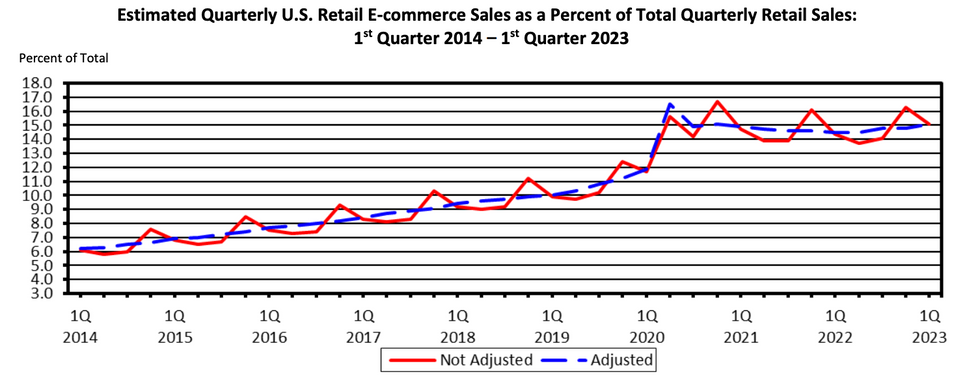Economy
18 May 2023
US ecommerce sales grow to 15% of retail in first quarter
Ecommerce is on track for another trillion-dollar year, US Commerce Department data shows.

Ecommerce is on track for another trillion-dollar year, US Commerce Department data shows.

US ecommerce sales showed growth to start the year, and gained share of total retail.
The US Department of Commerce reported the following:
Ecommerce sales for the first quarter of 2023 were $272.6 billion, adjusted for seasonal variation.
That’s an increase of 3% from the fourth quarter of 2022.
On an annual basis, ecommerce sales increased 7.8% from the first quarter of 2022.
That’s well above the growth rate of overall retail sales, which were up 3.4% year-over-year.
In all, ecommerce sales in the first quarter accounted for 15.1% of total retail sales.

Quick takeaways:
A fast start: Retail sales crossed the $1 trillion mark for the first time in 2022. That momentum is continuing into 2023, as the $272 billion total for the first quarter provides a big head start in once again topping the 12-figure threshold.
Gaining share: While ecommerce’s share of retail spiked north of 16% during the pandemic years, it came back to the 14% range in 2022. The start of 2023 shows that more steady growth is continuing to settle in. It shows that ecommerce is still making gains despite the return to stores, albeit on a more gradual trajectory.
Choosing ecommerce: While retail sales overall are showing more tepid growth to start the year, the data indicates that online shopping continues to be an attractive option. It likely helps that online prices have been falling while overall inflation is continuing to push prices up across the economy. Retailers also have more robust infrastructure for fulfillment and delivery following massive buildouts in the pandemic, particularly at grocers and mass retailers. This combination of price and convenience is proving to lift sales, even as we move squarely into a period when ecommerce is a choice rather than a health and safety necessity.
Campbell Soup Company CEO Mark Clouse offered thoughts on messaging amid inflationary shifts in consumer behavior.
After months of elevated inflation and interest rate hikes that have the potential to cool demand, consumers are showing more signs of shifting behavior.
It’s showing up in retail sales data, but there’s also evidence in the observations of the brands responsible for grocery store staples.
The latest example came this week from Campbell Soup Company. CEO Mark Clouse told analysts that the consumer continues to be “resilient” despite continued price increases on food, but found that “consumers are beginning to feel that pressure” as time goes on.
This shows up in the categories they are buying. Overall, Clouse said Campbell sees a shift toward shelf-stable items, and away from more expensive prepared foods.
There is also change in when they make purchases. People are buying more at the beginning of the month. That’s because they are stretching paychecks as long as possible.
These shifts change how the company is communicating with consumers.
Clouse said the changes in behavior are an opportunity to “focus on value within our messaging without necessarily having to chase pricing all the way down.”
“No question that it's important that we protect affordability and that we make that relevant in the categories that we're in," Clouse said. "But I also think there's a lot of ways to frame value in different ways, right?”
A meal cooked with condensed soup may be cheaper than picking up a frozen item or ordering out. Consumers just need a reminder. Even within Campbell’s own portfolio, the company can elevate brands that have more value now, even if they may not always get the limelight.
The open question is whether the shift in behavior will begin to show up in the results of the companies that have raised prices. Campbell’s overall net sales grew 5% for the quarter ended April 30, while gross profit margins held steady around 30%. But the category-level results were more uneven. U.S. soup sales declined 11%, though the company said that was owed to comparisons with the quarter when supply chains reopened a year ago and expressed confidence that the category is seeing a longer-term resurgence as more people cook at home following the pandemic. Snacks, which includes Goldfish and Pepperidge Farm, were up 12% And while net sales increased overall, the amount of products people are buying is declining. Volumes were down 7%.
These are trends happening across the grocery store. Campbell is continuing to compete. It is leading with iconic brands, and a host of different ways to consume them. It is following that up with innovation that makes the products stand out. Then, it is driving home messaging that shows consumers how to fit the products into their lives, and even their tightening spending plans.
Campbell Soup is more than 150 years old, and has seen plenty of difficult economic environments. It is also a different business today, and will continue to evolve. At the end of the day, continued execution is what’s required.
“If it's good food, people are going to buy it, especially if it's a great value,” Clouse said.